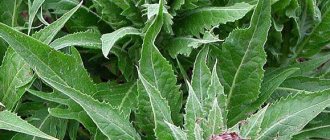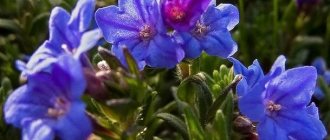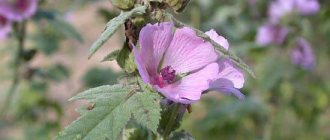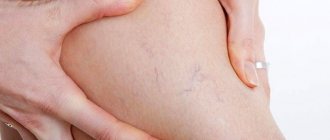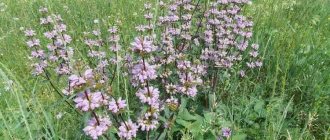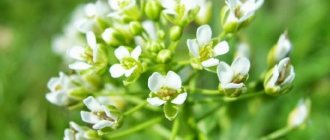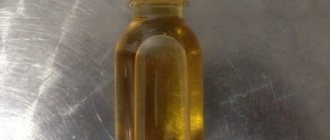Primula officinalis Jacq.
In the bright clearings of deciduous forests, on the edges and among sparse bushes, already in May the light yellow panicles of primroses delight our eyes. A rosette of ovate-elongated wrinkled leaves and several erect peduncles emerge from the powerful root system, which grow one after another as they bloom.
Rams are perennials, but they also reproduce well by seeds that ripen at the end of August, so you should leave the most powerful plants and not collect every last one - leaving large specimens will ensure reproduction for future years.
Biological description of Primrose officinalis
Primrose has many other popular names: rams, lambs, lady's hands, white letter, gasnik, heavenly keys, ears, flowers of St. Peter. The latter is associated with the legend that the plant grew on the spot where St. Peter dropped the keys to heaven. Moreover, the primrose inflorescence looks like a bunch of keys; according to another legend, these are the keys with which spring opens the doors to summer.
Primrose has a short horizontal rhizome; numerous thin succulent roots extend from it.
Primrose leaves are oblong-obovate, wrinkled, serrated or unclearly crenate at the edges, taper into a winged petiole and form a basal rosette. A leafless peduncle 5-30 cm high emerges from the center of the rosette.
The flowers are regular, yellow, 7-15 mm in diameter, five-membered, dimorphic, with a 10-toothed calyx, inclined to one side, bisexual, collected in a slightly drooping umbrella of 10-30 pieces. The corolla is fused-petalled at the base; petals are dull.
In the conditions of the central zone of the European part of Russia, the primrose blooms in April - July.
The fruit is a capsule.
Description and preparation
They are also called keys - the inflorescence resembles a bunch of keys. There was a legend that these golden keys of the goddess of Spring unlocked the doors to summer's warm weather, green grass and flowers. Grows in light mixed and deciduous forests, on forest edges and grassy slopes. It blooms in April–May, while the forests are slightly shaded by foliage.
Spring primrose Primula veris L., medicinal or true – family Primroses, class dicotyledons. A perennial plant with a powerful rhizome with numerous cord-like roots, from which emerges a rosette of oval-shaped leaves, narrowed into a winged petiole, with several leafless erect peduncles 10-20 cm tall, appearing one after another as they bloom.
Umbrella-shaped inflorescences of golden-yellow flowers with a pleasant honey aroma. The yellow color of the corolla of the flower is colored by the anthochlor pigment in the cell sap - the same one that colors lemon fruits.
The fruit is an erect capsule with teeth at the top; when they open in good weather, the seeds are scattered by the wind; in bad weather, the teeth bend inward and the capsule closes.
Leaves, flowers and the entire plant are collected and dried during or towards the end of flowering, dried quickly, if possible, heated to a temperature of 60 ° C, while vitamin C is almost completely preserved. All the beneficial properties of the dried plant are preserved during storage for a year. Rhizomes with roots are harvested in spring or autumn, peeled, washed, dried, dried outdoors in the shade or in dryers at a temperature of 35-40 ° C.
Primrose in Latin. The scientific generic name Primula comes from the Latin word prima - first, the diminutive form of this word is given because the plant blooms in the earliest spring, one of the first, hence the Russian generic name - primrose. The scientific species name veris is translated from Latin as spring.
What does primrose contain?
In the roots of primrose, saponins were found in an amount of 5-10%, essential oil - 0.08% and glycosides: primulaverip (primulaveroside), primverine (primveroside), which is a triterpene compound.
Saponins are also found in the leaves, flavonoids and saponins are found in the flowers. All parts of the plant are rich in ascorbic acid. In terms of dry matter, the leaves contain 5.9% and the flowers 4.7% ascorbic acid (vitamin C); a small amount of carotene was found in the leaves and roots.
Pharmacological properties of primrose
Action: due to the large amount of saponins, infusions and decoctions of primrose help in the treatment of colds, inflammation of the throat and larynx, flu, and bronchitis. Helps in the treatment of tuberculosis and pulmonary pneumoconiosis, an excellent expectorant. A course of primrose is recommended for smokers and people suffering from rheumatism. Compresses from the decoction reduce swelling and pain, and accelerate the healing of postoperative wounds.
Traditional medicine has used primrose for centuries to treat migraines, insomnia, and nervous tension. Primrose wine is recommended as a means of regulating blood circulation.
Primrose also has diuretic properties, so it is used to cleanse and detoxify the body.
Methods of preparation and use
Based on the medicinal primrose, traditional medicine suggests preparing useful water decoctions and infusions, alcohol tinctures and ointments for treating the skin. You can use either independently collected raw materials or herbs purchased at a pharmacy to create healing products.
Decoction
A decoction of spring primrose is beneficial for coughs, sore throats and bacterial processes in the respiratory tract. The remedy is prepared according to the following algorithm:
- Finely chop two large spoons of dry grass and pour boiling water in the volume of a glass.
- Heat over low heat for two minutes.
- Remove from the stove and leave for another 20 minutes under the lid.
- Strain from the sediment and cool.
When warm, the decoction is taken three times a day, a large spoonful. The product is most effective when taken on an empty stomach.
A decoction of spring primrose can be used as a gargle.
Tincture
An alcohol tincture of the roots and shoots of medicinal primrose has pronounced analgesic, sedative and expectorant properties. You can prepare it according to the following recipe:
- 100 g of dry raw materials are poured into a glass container and filled with 500 ml of medical alcohol 70%.
- Place the drug in a dark place for two weeks.
- Remove the container daily to shake thoroughly.
We recommend reading: Serpukha: description, medicinal properties, use, contraindications
The finished tincture is filtered and consumed three times a day, 20 drops each on an empty stomach. Since the product is very strong and can burn mucous membranes, it should first be diluted in a small amount of water.
Tincture of spring primrose can be used for rubbing against rheumatism.
Infusion, tea
For coughs and inflammation of the gums, a water infusion of medicinal primrose is recommended for use. It is done according to the following scheme:
- The dry grass of the plant is crushed in a volume of 15 g.
- Pour 250 ml of fresh boiling water over the raw material.
- Leave it covered for about an hour and then filter.
The finished infusion is taken one glass twice a day. For colds, it is recommended to preheat the product so that it is warm, but not scalding.
Advice! You can add a spoonful of honey to the infusion of medicinal primrose to improve the taste and enhance the benefits.
Spring primrose tea can be used in case of loss of strength and lack of vitamins. The cooking recipe looks like this:
- 5 g of crushed dry root is poured into 250 ml of hot liquid.
- Bring the mixture to a boil on the stove and immediately remove from the heat.
- Leave covered for another five minutes.
Strained tea can be consumed 250 ml up to three times a day.
Spring primrose tea can be brewed in combination with other medicinal herbs.
Fresh Juice
The juice from fresh leaves and roots of medicinal primrose contains the most active ingredients. You get it like this:
- The collected plant materials are thoroughly washed to remove dust and contaminants.
- Chop the leaves and stems and place them in a blender.
- Grind the greens until smooth.
- Pass the pulp through cheesecloth to squeeze out the pure juice.
You need to take 15 ml twice a day on an empty stomach. Spring primrose has a particularly good effect during the period of recovery after serious illnesses or operations.
To obtain primrose juice, only young and completely healthy leaves and stems are selected.
Ointment
For joint diseases, as well as for wounds, cuts and irritations, it is most convenient to use an ointment with the addition of medicinal primrose. At home it is done like this:
- Melt 250 g of Vaseline or butter in a water bath.
- Add 30 g of primrose leaves, previously crushed into powder.
- Mix the ingredients thoroughly and heat over low heat for two hours.
The finished liquid product is passed through cheesecloth to separate the sediment, and then cooled at room temperature and put in the refrigerator until completely solidified. The ointment should be used for compresses and rubbing for joint ailments and bruises.
Ointment with spring primrose promotes rapid resorption of bruises
When to collect and how to store Primrose officinalis
As a rule, the entire primrose plant is collected during flowering in May, and the roots in the fall. The leaves must be dried quickly, then the vitamins and beneficial properties of the raw materials will be preserved.
Rhizomes are harvested in the fall by digging them up with shovels. Clean off the soil, cut off the above-ground parts and quickly wash in cold running water. After preliminary drying in the open air, they are dried in attics under an iron roof, under sheds with good ventilation, or in dryers at a temperature of 40-50 degrees, spread in a thin layer on paper, fabric or sieves. Dry raw materials are packaged in bags or bales. Store in dry, well-ventilated areas. Shelf life is two years.
The leaves are collected at the beginning of flowering, plucking them with hands or cutting them with knives. Dry quickly in attics under an iron roof or in dryers at a temperature of 70-80 degrees, spreading them in a thin layer. Dry leaves are packed by pressing into bags. Store in dry, well-ventilated areas.
Flowers are collected at the beginning of flowering, picked by hand and placed in small baskets. Dry under shelters with good ventilation, spreading in a thin layer. Packed in metal cans of 5 or 10 kg and stored in dry, well-ventilated areas.
Primrose officinalis. Dosage forms
Primrose decoction (roots)
1 tbsp. (10 g.) Pour 250 ml of primrose roots. water, bring to a boil and simmer over low heat for 15 minutes. Remove from heat, cover with a lid, insulate and leave for half an hour. Strain. Bring the resulting decoction to its original volume using boiled water.
Take half a glass 3-4 times a day
Primrose decoction (leaves)
1 tbsp. pour 250 ml of primrose leaves. water, bring to a boil and simmer over low heat for 1 minute. Remove from heat, cover, wrap and leave for half an hour. Strain, squeeze out the raw materials.
Take 1-2 tbsp. 3 times a day.
Primrose tincture (flowers)
In a glass container (preferably dark glass), pour primrose flowers with high-quality vodka or 70% alcohol in a ratio of 1:5. Close the container tightly with a lid and leave in a dark place at room temperature for two weeks, remembering to shake periodically. Strain, squeeze out the raw materials.
Take 20 drops in water 3 times a day before meals.
For what diseases is primrose used?
Primrose in scientific medicine
The leaves of Folium Primuiae, the flowers of Flores Primulae and the rhizomes with roots of Radix Primulae are used. The leaves are used as a vitamin remedy for the preparation of vitamin C concentrates, which are recommended for the treatment of hypo- and vitamin deficiencies.
The roots contain saponins, glucosides, traces of essential oil, vitamins A and C. The roots are used as an excellent expectorant for respiratory diseases, especially bronchitis, pneumonia, whooping cough, asthma, and as a diuretic and diaphoretic for influenza.
Primrose in folk medicine
flowers are used as a diaphoretic for colds, migraines, dizziness, insomnia, fever, heart disease and pulmonary tuberculosis.
A decoction of the roots is used for bronchitis, pneumonia, whooping cough as a painkiller (for joint pain), for chronic constipation, headaches, and all diseases of the genitourinary tract and kidneys.
Powder from crushed primrose leaves is taken for a lack of vitamins in the body, lethargy, lack of appetite, and gum disease.
Primrose is used in homeopathy, and aqueous decoctions of the whole plant in veterinary medicine.
Use of primrose in medicine (recipes)
The rhizome of lambs in the form of a decoction or napara - 5 g per 1 glass of water - is used as an expectorant for bronchitis and coughs, diseases of the upper respiratory tract and colds. Thanks to the salicylic acid contained in primrose, the roots have a slight anti-inflammatory effect, stimulate metabolism and the secretion of gastric juices, sweat, and urine. The above decoction is consumed 1 tbsp. spoon with honey 4-5 times a day.
Flowers and the entire primrose plant also have an expectorant and anti-inflammatory effect; they are brewed at the rate of 5 g per 1 glass of water (the whole plant is taken 2 times more) and drunk in 5-6 doses, and also rinse the nose and gargle with steam. The same drug is used for headaches and to relieve fatigue, irritability, and as a mild sedative for children. Primrose leaves are rich in vitamin C, they are useful for use in cases of vitamin C deficiency and after serious illnesses, drink tea from the leaves with flowers (not boiled, but brewed), and cut into salads. Tea made from primrose herb is useful for people with joint diseases - it relieves pain, helps remove salts from the body, and has a mild sedative effect.
For poor appetite, cough, general weakness, hypovitaminosis, pneumonia, scurvy, take an infusion of primrose leaves: brew 5-10 g of leaf powder in 20 ml of boiling water, leave for 1 hour, strain. Take 1 tablespoon 3-4 times a day.
For insomnia, constipation, general weakness, poor appetite, dizziness, cough, kidney and bladder diseases, take an infusion of primrose roots as a diuretic: brew 5 g of roots in 200 ml of boiling water, let it brew for 2 hours, strain. Drink 1 tablespoon 3-4 times a day.
For pneumonia, bronchitis, and whooping cough, drink a decoction of primrose herb as an expectorant: boil 20 g of crushed herb in 200 ml of water for 20 minutes, strain. Take 1 tablespoon 3-4 times a day.
For dizziness, migraines, chronic constipation, take an infusion of primrose flowers: brew 25 g of primrose flowers in 200 ml of boiling water, let it brew for half an hour, strain. Drink 100-200 ml 1-3 times a day.
For respiratory diseases, gout, rheumatism, kidney and bladder diseases, take a decoction of primrose roots: boil 20 g of roots in 400 ml of water for 15 minutes, leave for 30 minutes, strain. Drink 100 ml 3-4 times a day.
A drink made from primrose flowers is very useful for strengthening general health: rinse 250 g of primrose flowers, add 1 liter of cold water, let it brew at room temperature until fermentation begins, add sugar or honey (to taste). Store the finished drink in a cool, dark place.
Tea with primrose: mix dried roots or leaves of primrose and St. John's wort herbs in equal quantities, chop. Brew as regular tea and drink with honey, sugar, jam, sweets, xylitol.
Fresh primrose leaves, collected at the beginning of flowering, are used to make salads .
Just two primrose leaves are enough to satisfy the body's daily need for vitamin C.
Spring primrose (medicinal): traditional medicine
Reader, did you do physical exercises today? Please do it!
For medicinal purposes, the leaves and flowers or roots of the primrose officinalis (pictured) are used, that is, all its parts have benefits. The raw materials are collected at the beginning of flowering (April-May), dried at a temperature of 120 degrees in the oven: this way, almost the entire supply of vitamin “C” will be preserved in the plant.
Before taking primrose products, you need to take into account its contraindications . Thus, the plant is quite allergenic, and cases of intolerance to it are not isolated . Spring primrose enhances blood clotting , and its use cannot be combined with anticoagulant therapy. During pregnancy, primrose threatens miscarriage, so its use is strictly prohibited.
Primrose medicinal for chronic bronchitis
This remedy helps well if you suffer from a chronic dry cough - from bronchitis. It can also be used for acute bronchitis. Take 3 tablespoons of dry roots of the plant, brew with half a liter of boiling water. Leave in a thermos for 6 hours and then drink 100 ml. three times a day for 10 days.
For vitamin deficiency
To “saturate” the body with ascorbic acid and other vitamins, you need to prepare a powder from the plant part of the spring primrose (medicinal). The dried plant is crushed, after which 5 g. brew the powder with half a glass of boiling water. After half an hour, filter the product, add a little salt (at the tip of a knife). Drink this remedy in small sips a day, this is how the treatment lasts 14-21 days.
For laryngitis
When inflammation of the larynx (laryngitis) is accompanied by a wet cough, spring primrose will also help improve expectoration and make the cough even more productive. You need to prepare a collection of plants: combine anise seeds, calendula flowers, primrose leaves and flowers, and chamomile flowers in equal parts. Pour a glass of boiling water over a spoonful of the mixture and leave for an hour. Drink 100 ml. three times a day.
Spring primrose for neuralgia
To treat nervous diseases, you need to consume primrose juice. To prepare, wash the plant with flowers, chop it, and squeeze out the juice. To carry out the treatment, mix a teaspoon of juice with the same amount of honey. Take this medicine with milk or water in sufficient quantities, repeat three times a day for 2 weeks.
Primrose: a recipe for angina pectoris
Spring primrose oil can be used to treat angina pectoris and other forms of cardiac ischemia. Collect the flowers of the plant, place them in a small jar (0.5 liters), and fill them not too tightly. Pour vegetable oil over the flowers so that it fills the jar to the top. Place the product on the window so that the sun hits it for 21 days. After this period has passed, the flowers are squeezed out and thrown away, and this oil is once again poured into new flowers of the plant. After another 21 days of standing on the windowsill, the product is filtered and stored in the cold. They are treated by taking 1 ml orally. twice a day for a month.



